AMD Kaveri Review: A8-7600 and A10-7850K Tested
by Ian Cutress & Rahul Garg on January 14, 2014 8:00 AM ESTCPU Performance: Continued
Xilisoft Video Converter 7 - link
The XVC test I normally do is updated to the full version of the software, and this time a different test as well. Here we take two different videos: a double UHD (3840x4320) clip of 10 minutes and a 640x266 DVD rip of a 2h20 film and convert both to iPod suitable formats. The reasoning here is simple – when frames are small enough to fit into memory, the algorithm has more chance to apply work between threads and process the video quicker. Results shown are in seconds and time taken to encode. XVC also offers acceleration via CUDA and AMD APP, so if these are available on the CPU we offer results with and without.
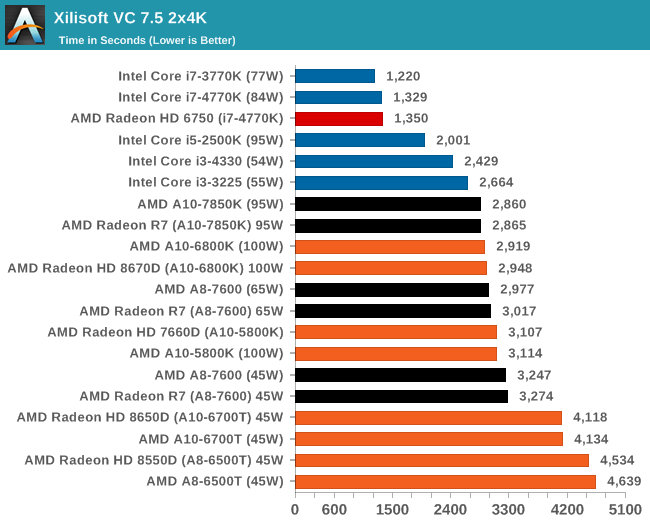
With large frame data, the IGP on Kaveri does not particularly help much.

For smaller frames however, there is an advantage to enabling the AMD APP function.
HandBrake v0.9.9 - link
For HandBrake we do the same files as XVC but convert them into the default format Handbrake offers upon loading the software. Results shown are in Frames Per Second.

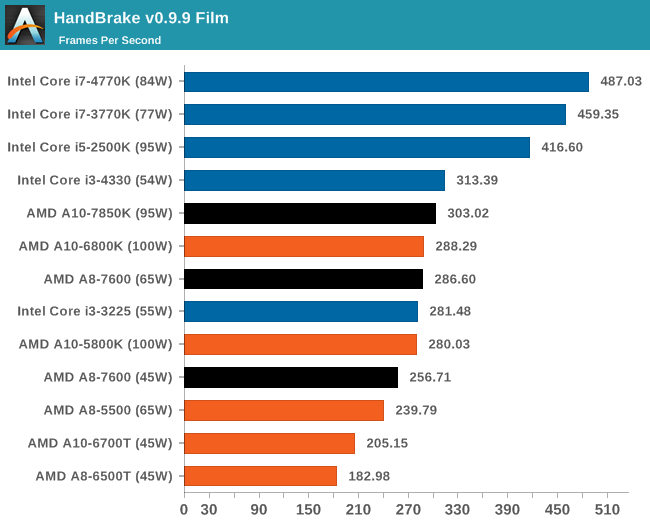
Handbrake loves cores, threads and MHz
Adobe After Effects 6
Published by Adobe, After Effects is a digital motion graphics, visual effects and compositing software package used in the post-production process of filmmaking and television production. For our benchmark we downloaded a common scene in use on the AE forums for benchmarks and placed it under our own circumstances for a repeatable benchmark. We generate 152 frames of the scene and present the time to do so based purely on CPU calculations.

7-Zip 9.2 - link
As an open source compression tool, 7-Zip is a popular tool for making sets of files easier to handle and transfer. The software offers up its own benchmark, to which we report the result.
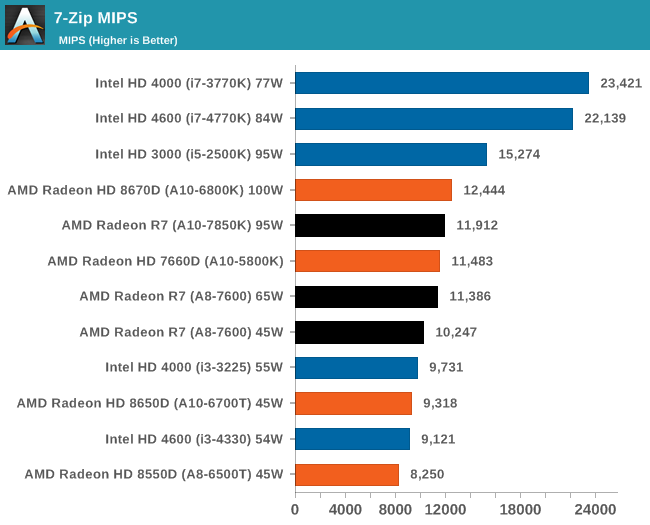
PovRay 3.7 - link
PovRay historically loves threads, MHz and IPC. The standard benchmark from PovRay is what we use to test here.
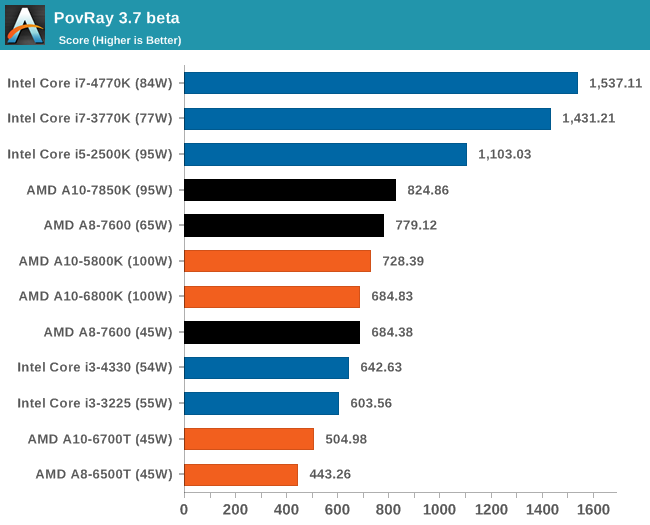
TrueCrypt 7.1a - link
TrueCrypt is an off the shelf open source encoding tool for files and folders. For our test we run the benchmark mode using a 1GB buffer and take the mean result from AES encryption.
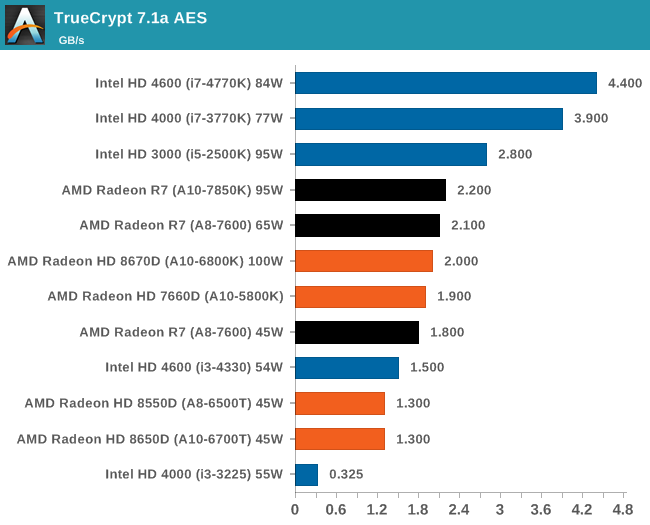










380 Comments
View All Comments
jaydee - Tuesday, January 14, 2014 - link
I just don't "get" adding three $300 Intel CPU's to a review of 3 sub $200 AMD CPU's. We all know, or can find out how i7 SB, IB, Haswell compare to each other. I can see adding one of these CPUs to show a baseline of how AMDs top-of-the-line compares against Intels (albiet at very different price points), but having all three of them gives the impression that you want to make sure everyone knows who's boss...Is there going to be an update on power draw? I'm really curious to see what the 45W Kaveri draws (idle and full power) considering it is so competitive with the 95W Kaveri.
jaydee - Tuesday, January 14, 2014 - link
I stand corrected, four $300+ Intel i7 CPUs in this comparison, not three. And two Intel CPU's that are actually in the price range of the AMDs. It feels as if to do this review, AT just cobbled together whatever was laying around instead of being intentional about putting together the best test bench possible to compare the review product against its real competitors.It's really a shame, because the commentary, the in-depth look at the architecture and the conclusions are outstanding; no website out there has tech writers as good and do as thorough of a job as Anandtech. The fact that the test benches are just after-thoughts in some of these reviews are really disappointing.
UtilityMax - Tuesday, January 14, 2014 - link
I think this was mentioned somewhere in the beginning of the review. Intel likes to have the i7 reviewed instead of other parts, so the send the i7 CPUs to everyone. This is kind of like what the car makers do. Most people just buy a reasonably priced, mid-spec car model. However, the journos always get to review these ridiculously over-optioned cars, that hardly sell, like the $35 Ford Fusions, even though the base car sells for 10 grand less.jaydee - Tuesday, January 14, 2014 - link
I am well aware that when having the choice, Intel would rather you review a $340 Intel CPU against a $179 AMD CPU. But is there not any way, given the ad revenue of Anandtech, to obtain a $190-200 mid-range Intel i5 CPU (such as the i5-4440) in order to have a relevant test bench for an eagerly anticipated AMD mid-range CPU launch?srkelley - Tuesday, January 14, 2014 - link
"...do any AnandTech readers have an interest in an even higher end APU with substantially more graphics horsepower?"Yes, oh yes! I'm letting the APU be the core of my system build in a few months and plan to upgrade as needed. I'd like a simple solution like an APU instead of having to go with a discrete card right away. If it lets me spend more on ram and other things, keep the psu and power draw low I'm happy. The most demanding game that I play right now is the Witcher 2. Eventually I will have to go discrete for Star Citizen and the Witcher 3 but if I can get solid enough results with a high powered apu then I'll simply jump to that instead.
Conduit - Tuesday, January 14, 2014 - link
This has been a long time coming thanks to Always Major Delays (AMD). Even know they can't get their sh!t together.nissangtr786 - Tuesday, January 14, 2014 - link
http://techreport.com/review/25908/amd-a8-7600-kav...The fpu still not improved miles still behind intel.
http://browser.primatelabs.com/geekbench3/326781
http://browser.primatelabs.com/geekbench3/321256
A5 - Tuesday, January 14, 2014 - link
"do any AnandTech readers have an interest in an even higher end APU with substantially more graphics horsepower? "Maybe in the context of a Steam Machine? But for my main gaming PC, no way. Maybe something they can try out after the next die shrink if SteamOS really takes off.
Xajel - Tuesday, January 14, 2014 - link
I believe the main reason for AMD to not have a new FX is SOI process.. it was okay in it's glory days, but it can't keep it up with bulk silicon...They want to increase the clock at least but they're trapped with 32nm SOI, and why not moving toward 28nm or lower SOI because I think that AMD is already working to convert it's entire CPU's to Bulk Silicon, so it's not logical to make a new design for still not ready yet 28nm or lower SOI while they are already designing the new core for bulk silicon.. knowing that both SOI and bulk require a complete redesign of the silicon just to convert from one to another... so it's not even logical to convert Pilediver or maybe even Steamroller to bulk silicon for only one year while they're working on the next architecture which will be Bulk Silicon...
jimjamjamie - Thursday, January 16, 2014 - link
That makes sense, I was very confused as to why AMD were not going to refresh the FX line - even if HSA is the future for AMD, I presumed new FX sales throughout this year would have helped things along.Perhaps it wasn't worth the cost, but at the same time AMD could really do with keeping the fanboys on side.